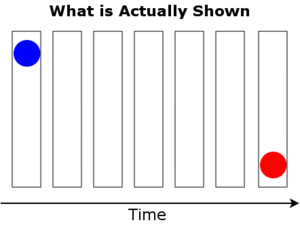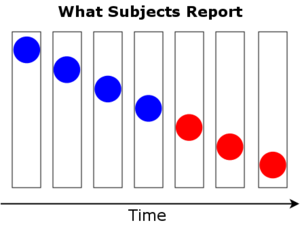The color phi phenomenon is a perceptual illusion described by psychologists Paul Kolers and Michael von Grunau in which a perception of motion and color change is produced by a sequence of still images. The color phi phenomenon is a more complex variation of a phi phenomenon called beta movement.
These illusions are distortions of sensory input, revealing how the brain organizes and interprets the information we receive from the world. Through studying this type of illusion scientists are able to discover how our minds function in informing us about the environment. In addition to providing ways to research human abilities, illusions like the color phi phenomenon intrigue and entertain people, reflecting our cognitive curiosity and appreciation for creativity that is part of human nature.
Discovery
The color phi phenomenon is based directly on beta movement, a type of phi phenomenon. In beta movement, two or more identical images located in different areas are flashed in sequence, making it appear as though the object or shape in the image moves from one position to another. The color phi phenomenon was discovered when the philosopher Nelson Goodman wondered if such a sense of motion would persist if the two alternating images were different colors, as well as what would happen to the perception of the object's color. Intrigued by these questions, psychologists Paul Kolers and Michael von Grunau investigated the effects of color upon beta movement.[1]
Description
People experience the color phi phenomenon very similarly to how they experience beta movement. In the classic example of beta movement, the viewer experiences a sense of movement of the object from one orientation to another. With the color phi phenomenon, the viewer also experiences a sense that the object is changing color abruptly in the middle of its illusory path.
Explanation
One of the most intriguing aspects of the color phi phenomenon is that viewers report a color change midway between the two flashing images, before the second image is actually shown. Logically, it is impossible for a subject to actually experience the color change before the second dot has been presented. On the other hand, some psychologists have argued that this should not be surprising. Hoffman noted that our perception is a construction, and thus a construction that differs from the actual physical stimulation is not unusual:
[I]t's not different. You construct the 3D space you see, you construct the motions you see in that space, and therefore you construct the time sequence of events you see. Space and time are, in this sense, on equal footing: you construct both. If what you construct doesn't match the construction of photometers, clocks, and rulers, that's no surprise. That's what you always do. And that's why you inhabit a much richer visual world, and have far more flexible and intelligent interactions with that world, than a photometer or clock. It's not that you've got it wrong because you disagree with the photometer and clock, it's that the photometer and clock aren't sophisticated enough to see what you do.[2]
Philosopher Daniel Dennett, who is known for his consciousness studies as well as his work on intentionality, artificial intelligence, and free will, has postulated theories as to how this is possible. Dennett discards both the idea that memory is altered to include a change of color after the second color is flashed, as well as the idea that memories are stored briefly until they are edited and brought into consciousness. He proposes a theory of consciousness that he calls a "Multiple Drafts Model," which he explains by using the color phi phenomenon. With this theory, experience is a "web of words and deeds," and any sense of a sequential order of events is due to probing this web or stream of experience at certain points. Dennett's argument, however, is somewhat vague, and often challenged by critics. Some suggest that future advancements in brain imaging techniques may make it clear exactly how the brain processes information and explain why the color phi phenomenon exists.[3]
Applications
The color phi phenomenon provides an interesting example for formulating and testing theories on how consciousness works, as well as how the brain functions. Additionally, it is provides an intriguing experience for the general public to discover the complexity of our ability to relate to the world that surrounds us.
Notes
- ↑ Phi Phenomenon Introduction UNC Charlotte. Retrieved October 30, 2007.
- ↑ Donald D. Hoffman, Visual Intelligence: How We Create What We See (W. W. Norton. 2000 ISBN 0393319679) p. 144
- ↑ Susan Schneider (2007) "Daniel Dennett on the Nature of Consciousness" University of Pennsylvania. Retrieved October 30, 2007.
ReferencesISBN links support NWE through referral fees
- Carruthers, Peter. "Language, Thought and Consciousness: An Essay in Philosophical Psychology." March 1998. Cambridge University Press. ISBN 0521639999
- Dennett, D.C.. "Consciousness Explained." 1993. Penguin Books Ltd.. ISBN 0140128670
- Hoffman, Donald D. 2000. Visual Intelligence: How We Create What We See. W. W. Norton. ISBN 0393319679
- Noe, Alva. "Is the Visual World a Grand Illusion? (Journal of Consciousness Studies Controversies in Science & the Humanities)." June 2002. Imprint Academic. ISBN 0907845231
Credits
New World Encyclopedia writers and editors rewrote and completed the Wikipedia article in accordance with New World Encyclopedia standards. This article abides by terms of the Creative Commons CC-by-sa 3.0 License (CC-by-sa), which may be used and disseminated with proper attribution. Credit is due under the terms of this license that can reference both the New World Encyclopedia contributors and the selfless volunteer contributors of the Wikimedia Foundation. To cite this article click here for a list of acceptable citing formats.The history of earlier contributions by wikipedians is accessible to researchers here:
The history of this article since it was imported to New World Encyclopedia:
Note: Some restrictions may apply to use of individual images which are separately licensed.

